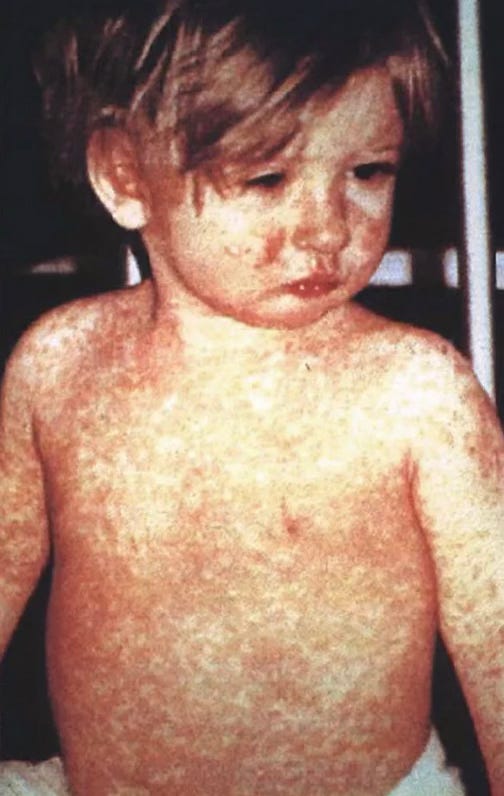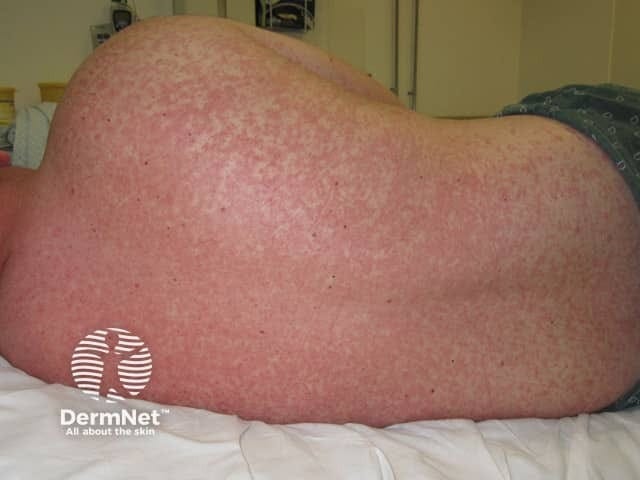Heartbreaking news out of West Texas in the United States. A school-aged child died of complications from measles. This is the first measles death in the US since 2015. The child was unvaccinated. My heart is heavy as a pediatrician and as a parent and grandparent.
I am an old enough physician that I have seen measles. With the development of the combined MMR vaccination in 1971 and school mandates in the later 1970’s, cases of measles started to subside. By the year 2000 the disease was considered eradicated from the United States. This made it difficult for younger physicians to see the illness first-hand unless they worked abroad.
Because of my longevity (!) and my experience with the disease, sometimes I would get a call to take a look at a child who was in the Emergency Room with a fever and a rash. (“Hey, can you come down and see if you think this is measles.”)
Here’s the deal - the minute you look at a child - you can tell if it’s measles. The child is SICK. The child has a high fever, a runny nose, and watery eyes. The child is looking down and doesn’t look at you because the light hurts their eyes. This is a symptom called photophobia. I haven’t seen a case of measles in a long while (as the disease was being eradicated) and I hope I never do again as these kids are SICK.
Measles
The disease is transmitted through the air via respiratory droplets (cough, sneeze)
The virus can survive for two hours on a countertop or a railing or a chair. Thus, the person with the virus can leave the room but the virus lingers.
The incubation period is 10-14 days. Measles is crazy contagious because an infected person is contagious 4 days before symptoms (and remains infectious for at least 4 days after the rash presents).
Symptoms: cough, runny nose, conjunctivitis (inflamed eyes), sore throat, spots in the mouth called Koplik spots, fever (high fever), and a classic skin rash. The rash starts at the hairline on the head and spreads down behind the ears, down the face, neck, trunk, arms and legs.
From my medical school days:
For measles remember the 3 “Cs”: cough - coryza (runny nose) - conjunctivitis - then fever and rash.
Koplik spots in the mouth come a few days before the rash.
Remember how the rash spreads by envisioning how a bucket of paint would spread if it was dumped on your head: starting on the head and then going to the face, neck, trunk, arms, legs.
Approximately 30% of patients who have measles develop one or more complications.
Serious complications include diarrhea that can lead to dehydration, pneumonia that can be severe enough to require ventilation, blindness, and encephalitis.
In some children the infection gets better but the virus hides in the body - coming back 7-10 years after the infection as SSPE (subacute sclerosis pan encephalitis). This awful disese is an inflammation of the brain that leads to to progressive brain damage.
I think we get fooled because kids get viral illnesses all the time. Fever - runny nose - rash - the child is sick for a few days and then is running around. However, measles is a nasty viral illness that can land a child in the hospital and then can come back years later. I think if there was a lot of measles around, parents would be talking about it and then they would know why so many pediatricians, other physicians and scientists are speaking out.
Herd immunity >95% contains the spread.
Measles is insanely contagious.
“Measles spreads like wildfire in unprotected communities - it’s the most contagious virus on earth.” (1)
Compare these illnesses:
1 person with flu usually infects 1-2 two people.
1 person with norovirus usually infects 2-4 people.
1 person with measles usually infects 12-18 people and 2-4 of them will need care in a hospital
This is a preventable illness.
Treatment is prevention through vaccinations. The vaccination schedule for children for MMR (Measles, Mumps, Rubella) is a 2-dose series:
12-15 months - minimum age 12 months for routine vaccination (but can be given as young as 6 months in certain circumstances)
4-6 years
More than 93 % of individuals who receive a single dose of MMR will develop immunity to measles. Two doses increase this protection to approximately 97 %.
If the mother has immunity to measles, the placenta will share those antibodies with the fetus and newborn. That protection should last for about 6 months.
Learn much more by following
Your Local Epidemiologist Substack link
Beyond the Noise with Paul Offit Substack link
ImmunoLogic Substack link
References
Gastañaduy PA, Goodson JL, Panagiotakopoulos L, et al. Measles in the 21st Century: Progress Toward Achieving and Sustaining Elimination. J Infect Dis. 2021 Sep 30;224(Suppl 4):S420-S428. doi:10.1093/infdis/jiaa793
Here is the link. This is an open access (free) article. PubMed Link







Or, if more women had natural measles as a child, mama would be protecting baby through breastfeeding. I can’t believe that little old me, just a mom, had to say this on a page that is oriented towards the science and promotion of human lactation. Please do better.